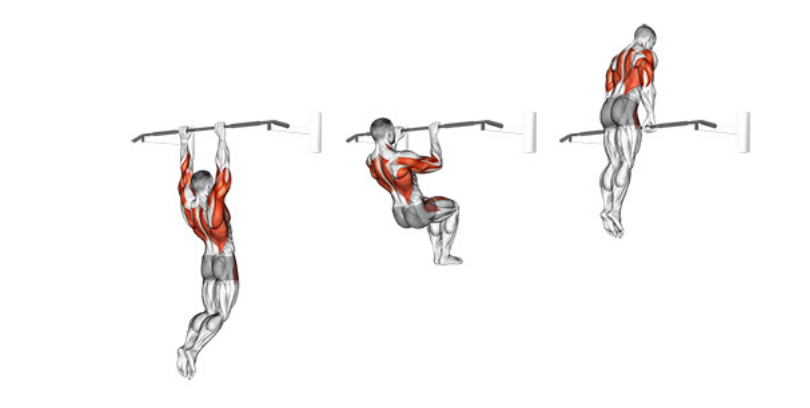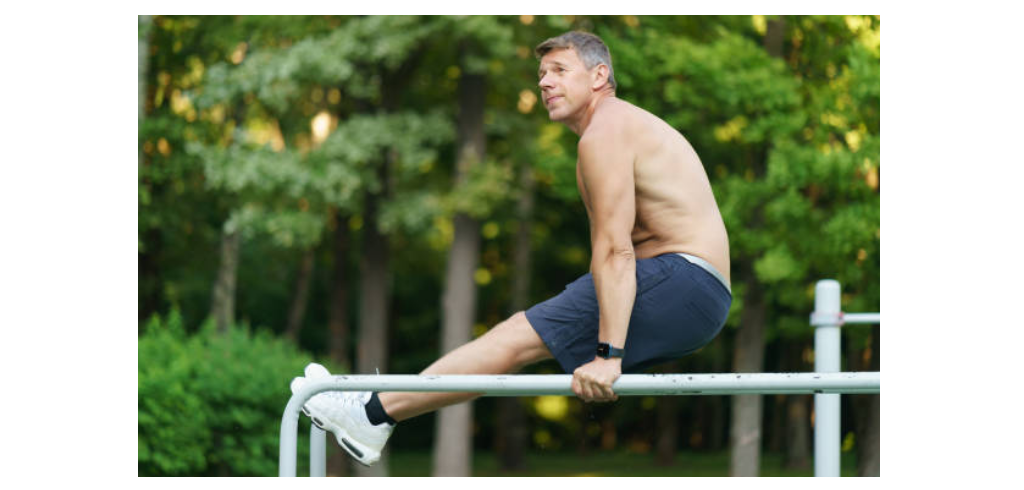What are Muscle-Ups?
Muscle-ups are a complex bodyweight exercise that combines the execution of a pull-up and a triceps dip.
They activate your triceps, lats, deltoids, and pectorals, as it requires a combination of upper body and core strength. Also, joint stability and good body control are important for proper technique and coordination.
This includes a concentric (refers to the “positive” movement) as well as an eccentric movement (refers to the “negative” movement), which means the muscles are contracting concentrically in the ascendant part, and contracting eccentrically in the descendent part. This exercise is often used in Calisthenics and CrossFit training as a measure of upper body and core strength.
The movement starts with a pull-up, where the power comes from the latissimus dorsi muscle of the back, the pectorals, and the biceps when you pull the body up to the bar. Then through a controlled momentum transition to a dip by engaging the core and pushing your body up and over the bar. Lastly, the triceps and deltoids finish this exercise with the arms extended in a dip position.
In order to safely attempt to learn the muscle-up, one must have already established bodyweight strength, stability, and coordination.

Source: https://www.hevyapp.com/exercises/muscle-up/
Which muscles are being worked on?
We work the frontal as well as the posterior chain of muscle groups, mainly of the upper body.
The muscles included are as followed:
- Lats (latissimus dorsi): Pulls the body up
- Biceps: Helps with pulling motion
- Pectoralis major: Helps push the body over the bar
- Triceps: Pushing motion of the dip
- Core: Stabilizes the body during the entire movement
- Shoulders: Keeps the shoulders stable and maintains posture
- Handflexors: For the grip to secure the bar
- Forearms: Help in pulling and pushing motion
Benefits of Muscle-ups
One of the major benefits is the increased upper body and core strength as we use multiple muscle groups, including the lats, biceps, triceps, pecs, core, and shoulders.
By doing that we also obtain an aesthetic benefit as we build a better definition of the muscles and also help for muscle growth when training the upper body as a whole and not isolated by muscle groups. With this comes greater functionality due to muscle coordination which can also transfer to other types of workouts as a benefit.
We improve tendon strength when lowering the body to start a sequence of repetition as we work on eccentric (negative) movements. Repeating this exercise leads to a healthier heart and cardiovascular fitness.
Muscle-Up Progressions
Beginner level: Pull-up and dip progressions
It is important to build strength and control of the muscles used to execute a pull-up and dip.
Ideally, you can do 8-10 pull-ups and triceps dips before beginning the practice of muscle-ups.
You can practice these exercises also by starting off with band-assisted pull-ups, including also negative pull-ups, and bench dips to help build the strength and control needed for a muscle-up.
Intermediate level: Transition and false grip progressions
These progressions involve practicing the transition from the pull-up to the dip, as well as working on the false grip.
Exercises such as:
- Hollow holds – You lay on your back, with arms stretched out over your head and legs held together, from here you lift your arms and legs, bringing the chin to the chest by elevating your head and engaging the core, hold this position for 10 secs.
- Hollow rocks – Return to the same position as for the hollow hold, but this time we add movement by rocking back and forth.
- Muscle-up transitions can help with the transition
- False grip: Instead of enclosing the bar with your fingers only, place your palm on the bar and bring the thumb along with the other fingers, therefore you have more contact on the bar with your hand and also your wrist.
Advanced level: Full muscle up progressions
Exercises such as jumping muscle-ups, half muscle-ups, and full muscle-ups can help strengthen the muscles and improve the coordination needed for a successful muscle-up.
Workout Routines

Sample workout routines for each level of progression
Beginner level
- Assisted pull-ups: 3 sets of 8 reps, using a band, box, or machine to provide assistance
- Negative pull-ups: 3 sets of 5 reps, focusing on a slow and controlled descent
- Banded pull-ups: 3 sets of 8 reps, using a band for assistance
- Assisted dips: 3 sets of 8 reps, using a machine or band for assistance
- Box dips: 3 sets of 8 reps, using a box or bench for assistance
- Push-ups: 3 sets of 12 reps, focusing on proper form and technique
Repeat 2-3 times per week, with a day of rest in between.
As you progress, you can begin to reduce the assistance used in the pull-up and dip exercises and add in exercises that target the transition from pull-up to dip.
Intermediate level
- False Grip Pull-ups: Grip the bar with your palms facing down and your fingers wrapped around the bar. Perform pull-ups while maintaining the false grip position. – 3 sets of 6 reps
- Ring rows: Hold onto the rings with your palms facing you and your fingers wrapped around the rings. Perform rows by pulling your chest towards the rings. – 3 sets of 8 reps
- Jumping muscle-ups: Jump up to the top position of a muscle-up, then lower yourself down. Use a box or bench to assist with the jumping motion. – 3 sets of 5 reps
- False grip ring transitions: Start in a false grip on the rings with your palms facing you and your fingers wrapped around the rings. Transition from the pull-up position to the dip position. – 3 sets of 5 reps
- Ring muscle-ups: Start in a false grip on the rings with your palms facing you and your fingers wrapped around the rings. Perform a muscle-up by transitioning from the pull-up position to the dip position. – 3 sets of 3 reps.
Rest for 30 seconds between each set and 1 minute between each exercise.
Repeat the workout twice a week, and try to increase the reps or decrease the assistance over time.
Advanced
- Warm-up: 5 minutes of light cardio (jumping jacks, jumping rope, etc.) and use dynamic stretches (leg swings, arm circles, etc.).
- Pull-up and dip progressions: 3 sets of 8-10 reps of strict pull-ups, 3 sets of 8-10 reps of strict dips. Rest 60 seconds between sets
- Transition work:
- 3 sets of 3-5 reps of jumping muscle-ups
- 3 sets of 3-5 reps of false grip pull-ups
- 3 sets of 3-5 reps of ring rows
- Rest 60 seconds between sets
- Putting it all together: 3 sets of 1-3 reps of full muscle-ups. Rest 60 seconds between the sets
- Cool-down: 5 minutes of light cardio (jogging, cycling, etc.), Static stretching (hold each stretch for 20-30 seconds)
Tips for incorporating muscle-ups into your existing workout routine
1. Start with progressions: Gradually build up the strength and technique required for the movement. Progressions such as pull-ups, ring rows, and ring dips are good starting points.
2. Use assisted muscle ups: Utilizing a resistance band can help reduce the amount of body weight you need to lift. This can build up the strength you need to do it without assistance and also improves your technique.
3. Incorporate muscle-up-specific exercises: Incorporate exercises that mimic the movements involved in a muscle-up, such as ring rows, false grip pull-ups, and jumping muscle-ups.
4. Add high-intensity intervals: Try doing short bursts of pull-ups, dips, and other exercises that target the same muscles used in a muscle up.
5. Focus on form: Make sure you are using the correct technique and focusing on engaging the right muscles. Taking the time to optimise your form can help you get the most out of your muscle-up workouts.
FAQs
How long does it take to learn a muscle-up?
It depends on your current fitness level. Some factors include:
- Starting fitness level
- Training consistency
- Technique application
- Age and/or gender
- History of injuries
Can I do Muscle-Ups if I am not strong enough for a pull-up?
The short answer is “no.” Being able to do pull-ups consistently is the foundation of a good muscle-up. Some recommend a starting point of being capable of 10 straight pull-ups to get started on muscle-ups.
How often should I practice muscle-ups?
Start by training regularly, not more than two times a week. If you see good progress in your new routine, you can add a third workout session in week three.
Especially in the beginning do not overdo it in the hope to see quicker results. Give your body the time needed to recover and adapt to these- for the muscles, new interaction of movement.
While it’s crucial to routinely do Muscle-Up progressions to improve strength and technique, it’s also crucial to make time for rest and recovery. Overtraining can result in harm, exhaustion, and a lack of advancement.
How can I work on my grip strength for muscle-ups?

Incorporate grip-strengthening workouts like:
- Dead hangs – Where you reach for a bar and hold on to it, and basically hang there until you feel like you lose your grip and start slipping.
- Farmer’s walks – Take a dumbbell in each hand, which you can hold for the next 20-30 secs. while walking back and forth in an upright position. The arms are next to the body, and the shoulders and the core are engaged
- Finger rolls – Use an Olympic Weightlifting Bar and grasp the bar from underneath (underhand grip) while standing in an upright position, with the chest up and slightly bent knees. Roll the bar slowly down and up your fingers by opening and closing your hands.
- Plate pinch – Here you train especially the strength of the finger. Grab a weight plate with each hand, which you are able to hold between your four fingers and your thumb by pinching the plate. The position is upright, arms are next to the body and hold for 20-30 secs. For progress take two plates in each hand.
- Rope climbing – Climb up and slowly down on any hanging and secured rope, -many Calisthenic / Crossfit Workout places have those installed in their facilities.
Are muscle-ups safe for my shoulders?
The shoulder joint is a complex multiaxial joint, which is prone to injuries if you neglect the right techniques when exercising. You should avoid this exercise if you are already feeling pain when performing pull-ups or triceps dips or have any previous shoulder injuries.
It is best, to begin with pull-up and triceps-dip progressions to build strength and be able to achieve a good technique. It is recommended that you seek the advice of a professional trainer or coach to ensure proper form and technique.
On any occasion, if you feel pain or discomfort while performing muscle-ups, you should stop and seek advice from a physical therapist or orthopedic doctor.
To continue:
As muscle-ups is a challenging but beneficial exercise, make sure to follow our guide.
Click the link below, to find our 4-week program on how to achieve your first muscle-up or to improve your technique.

Chris is an experienced Calisthenics practitioner focused on isometric exercises and street workout. He founded thehybridathlete.com in 2017, which was subsequently acquired by theyhybridathlete.com
He is based in Portland and has been working out using solely his own body weight and bars for the past 6 years.

